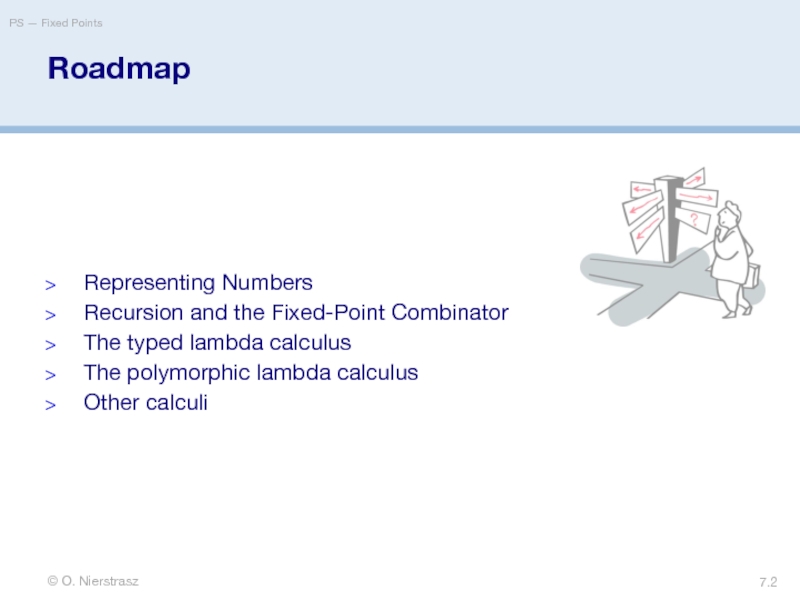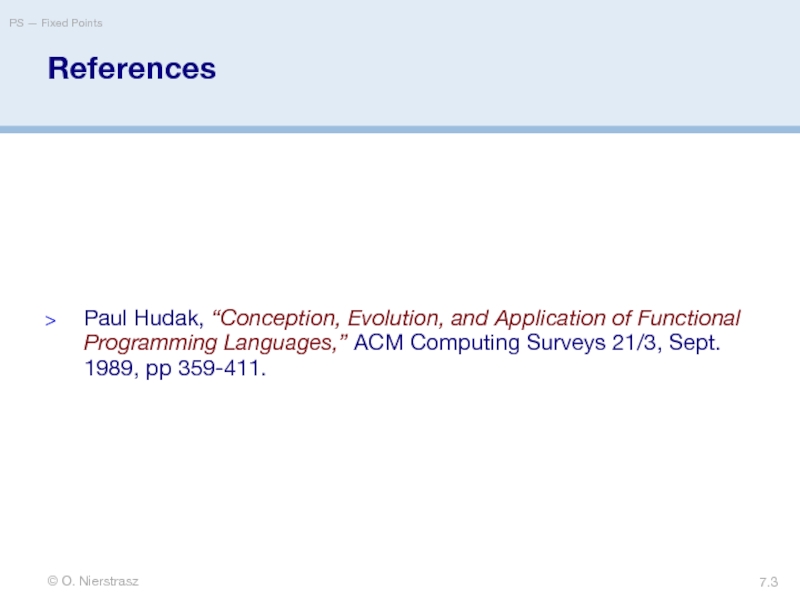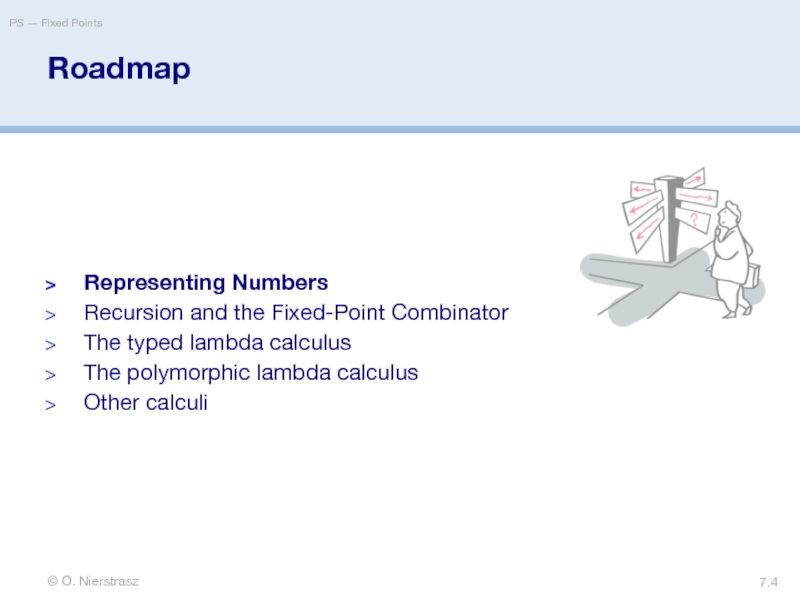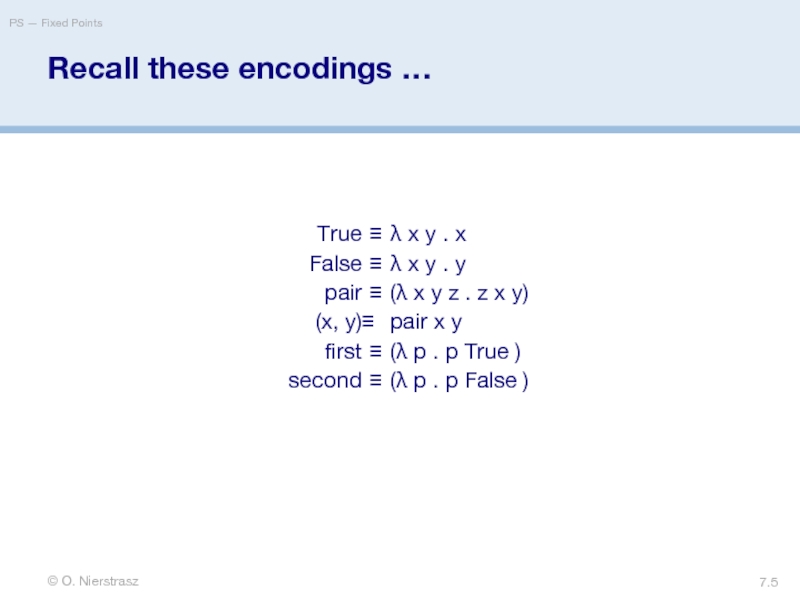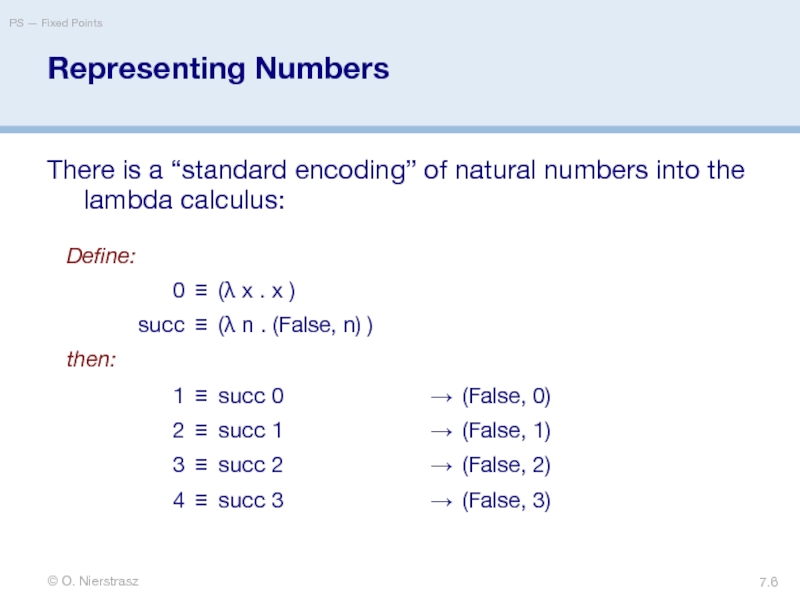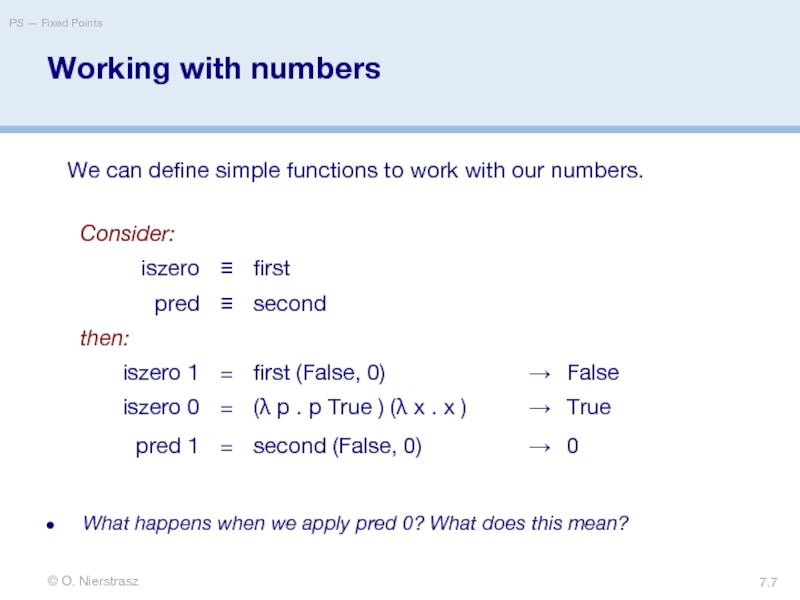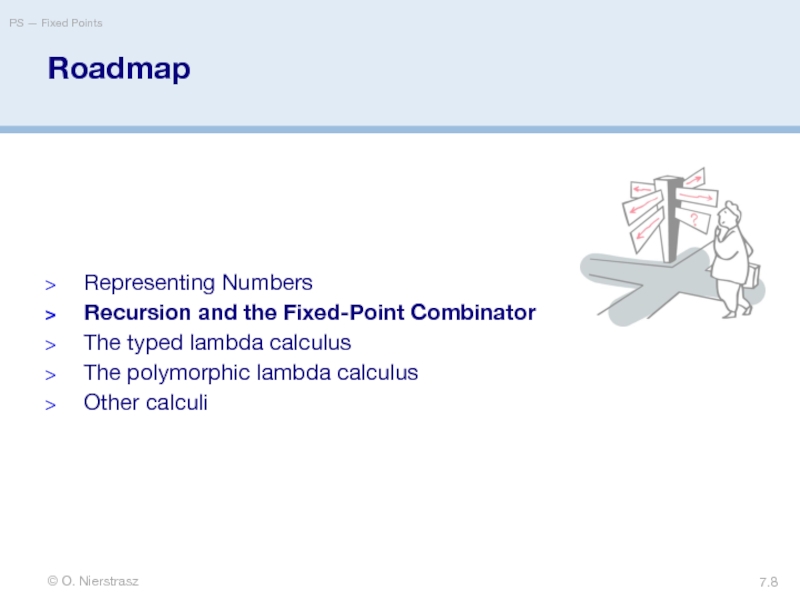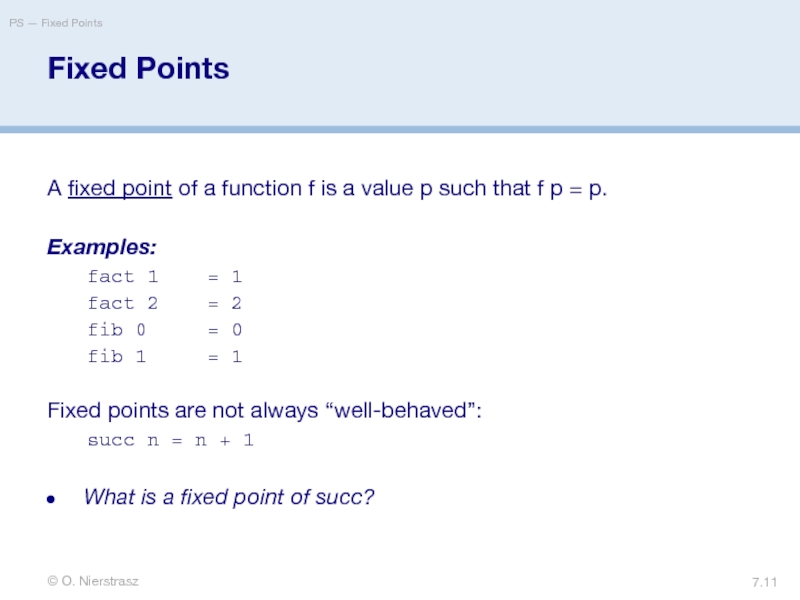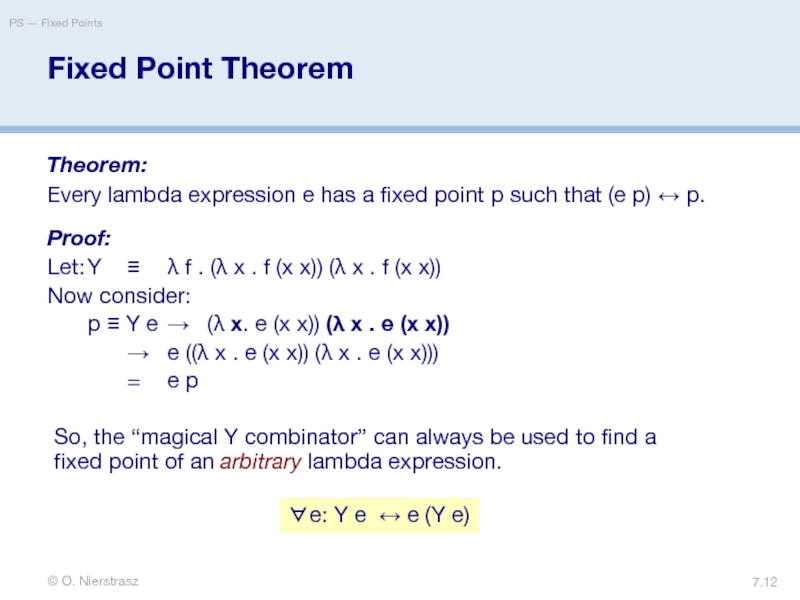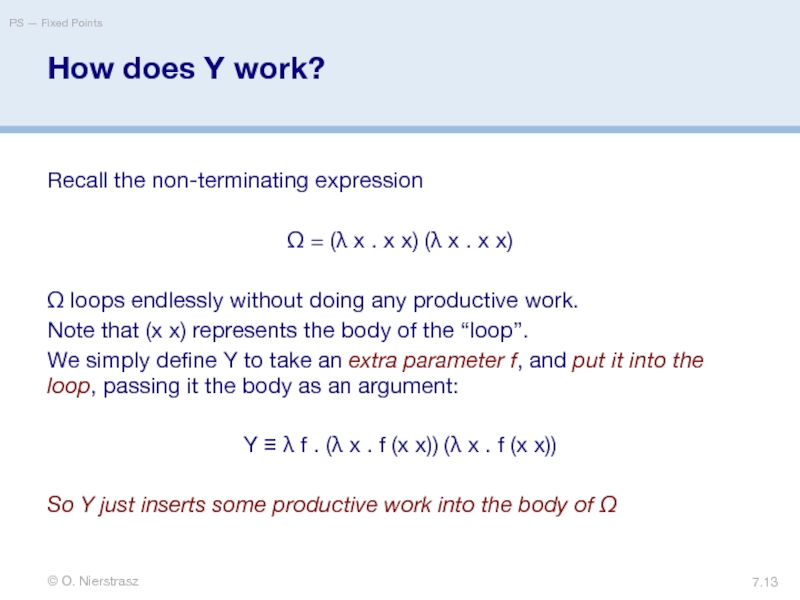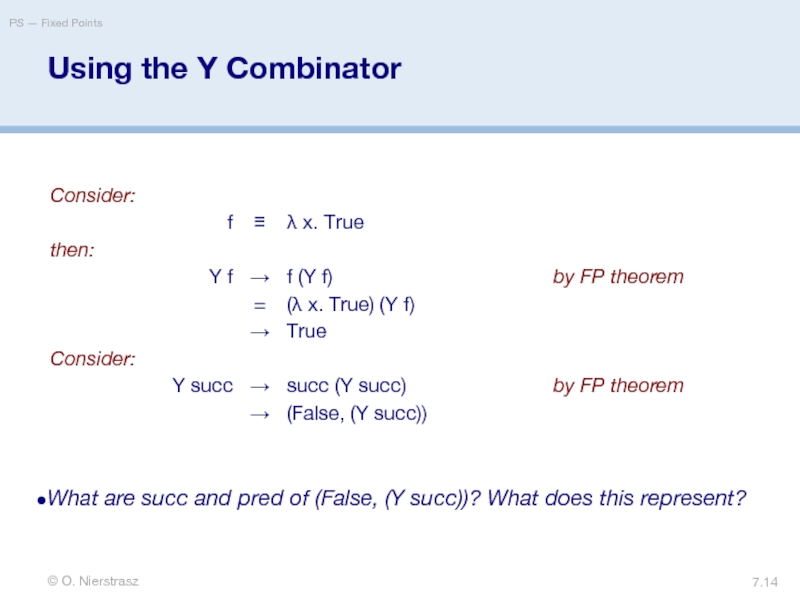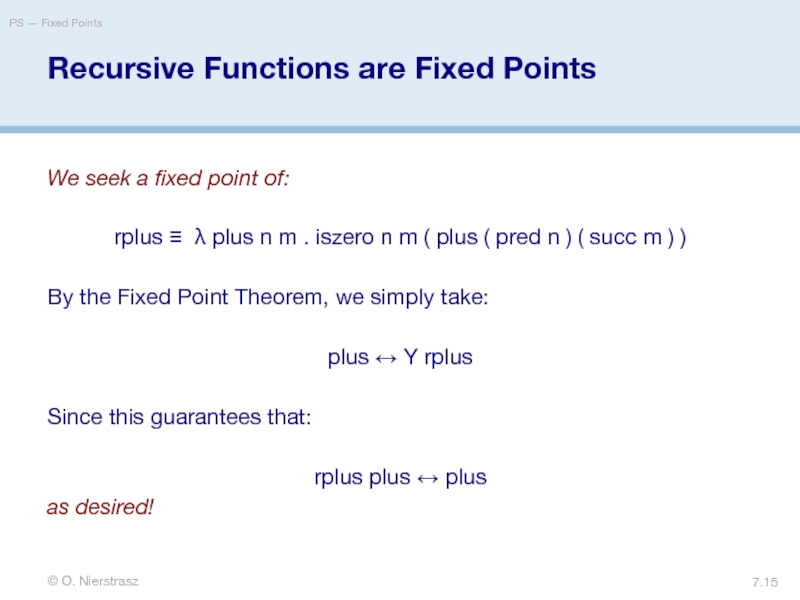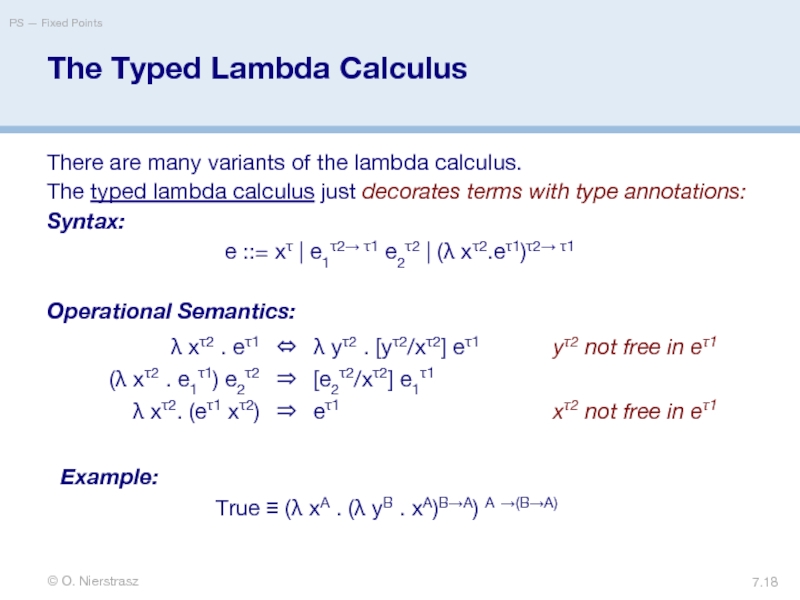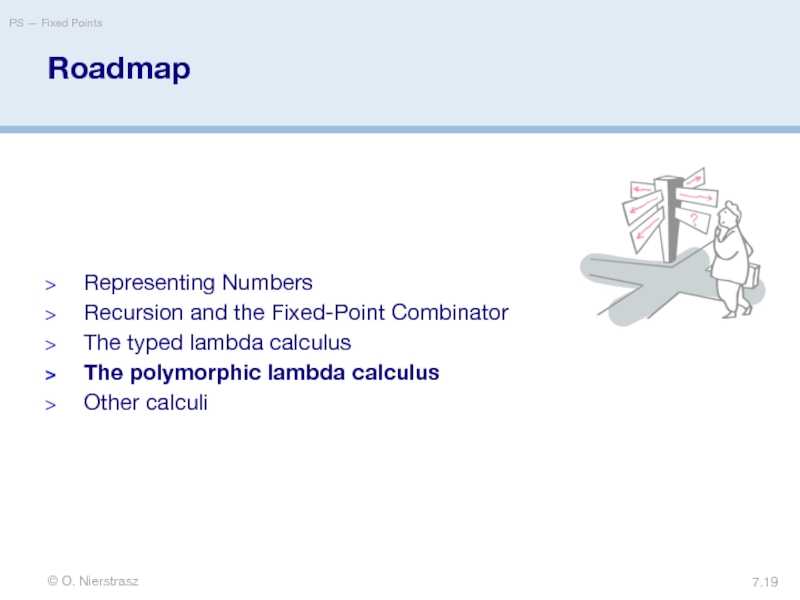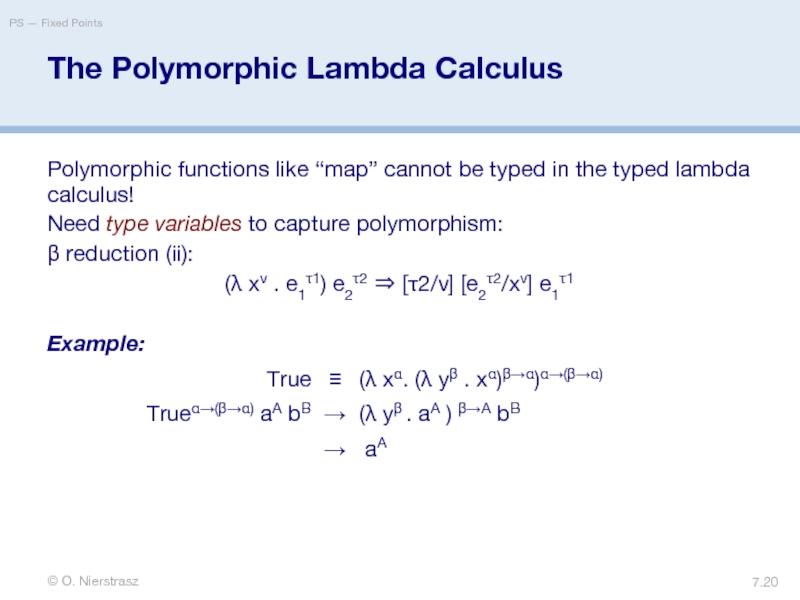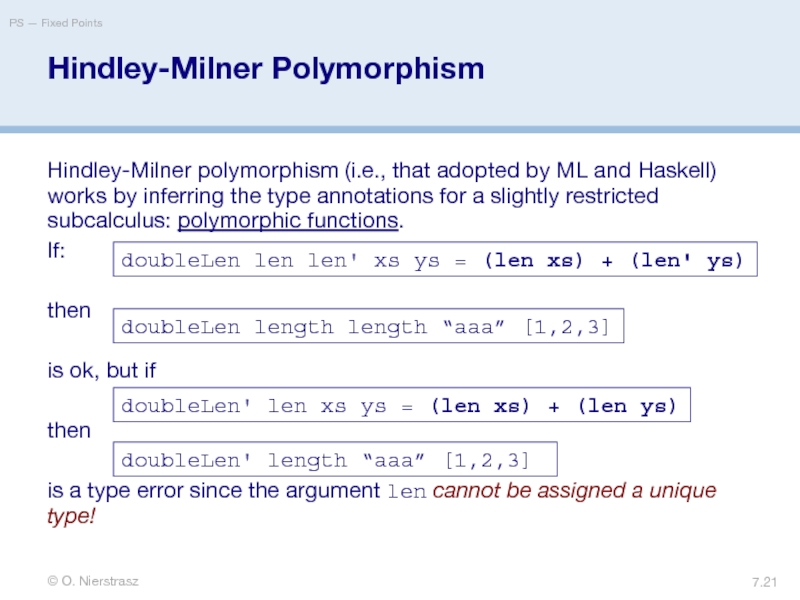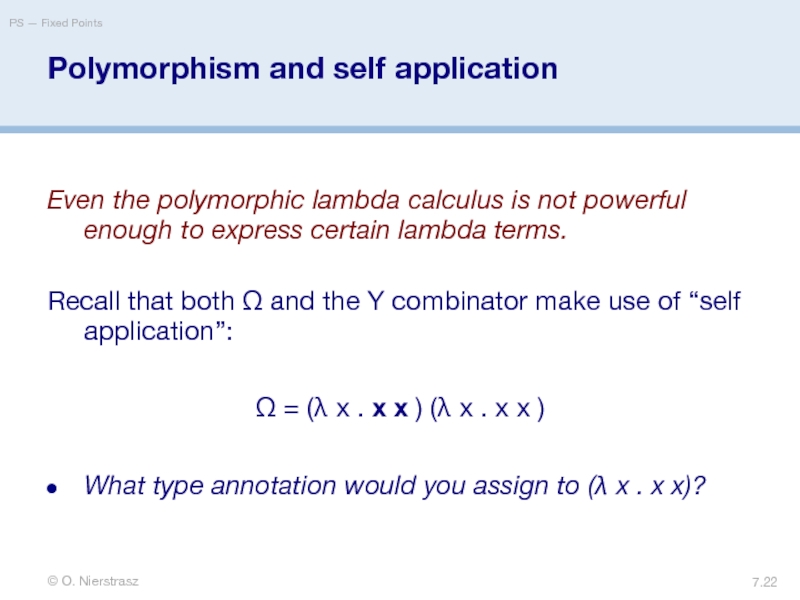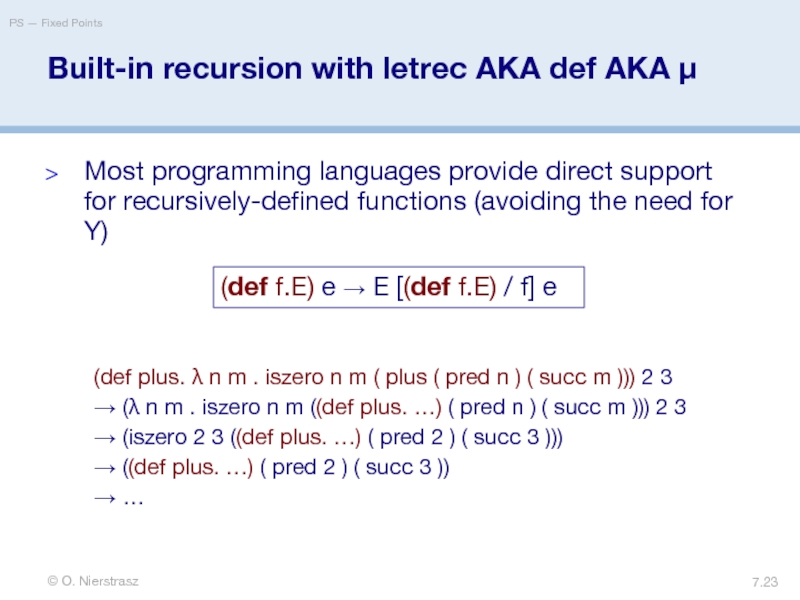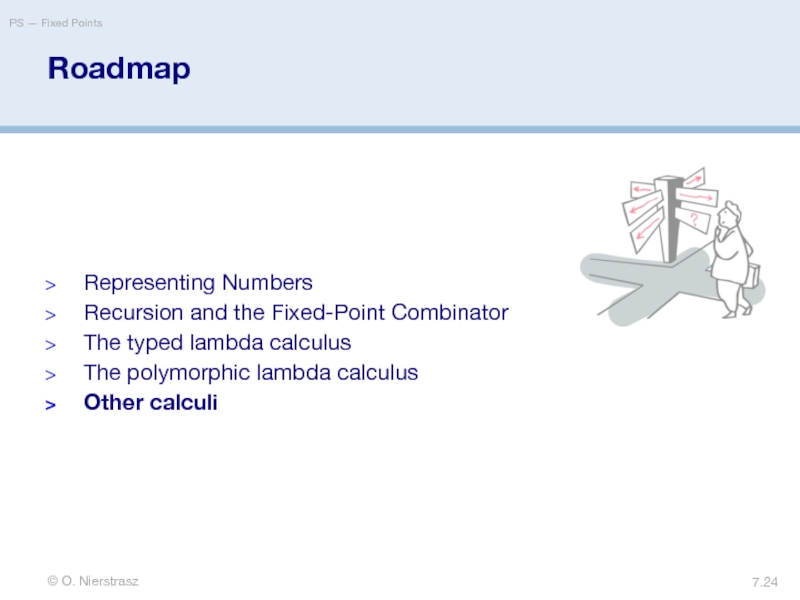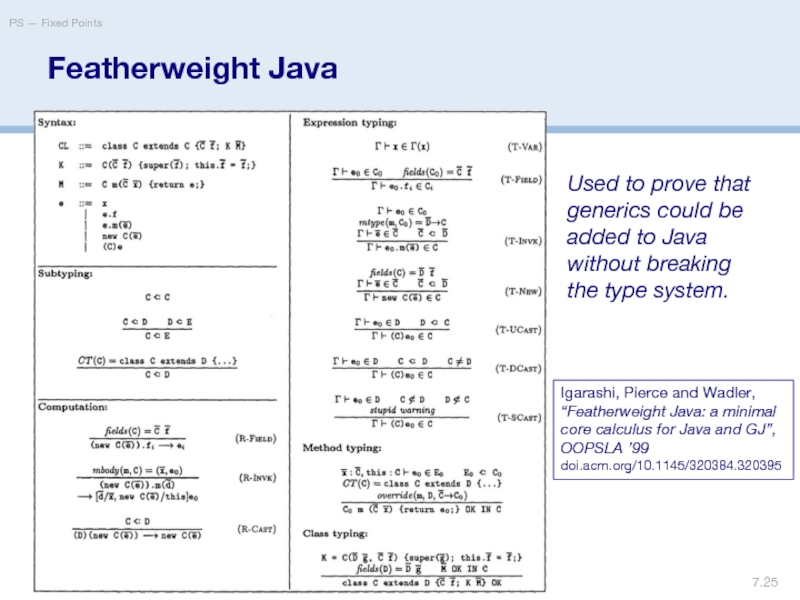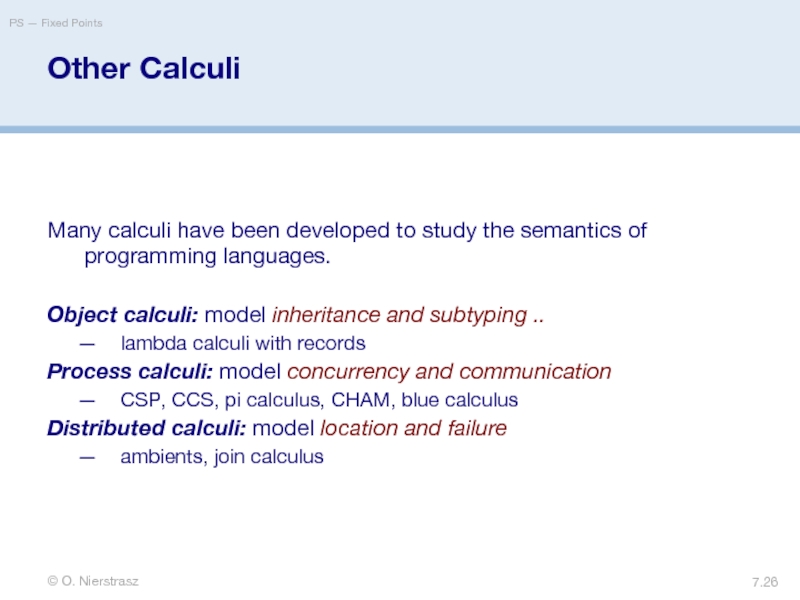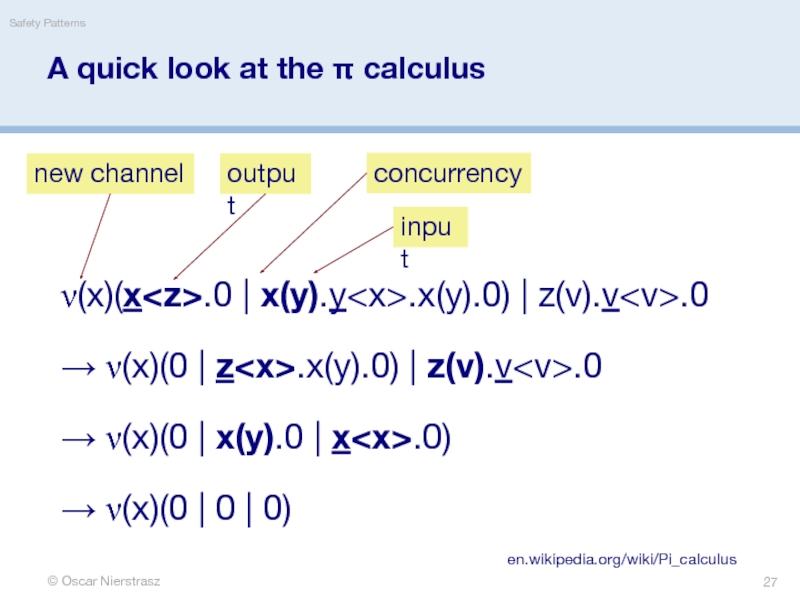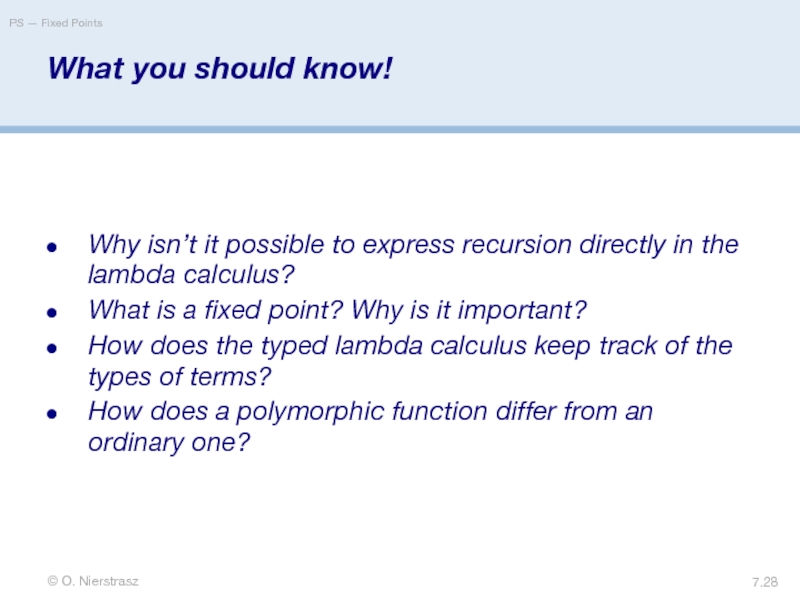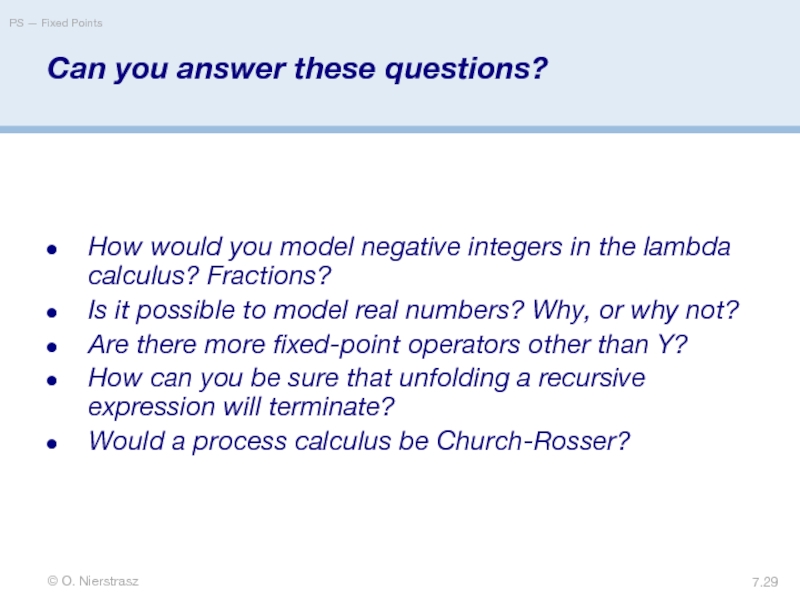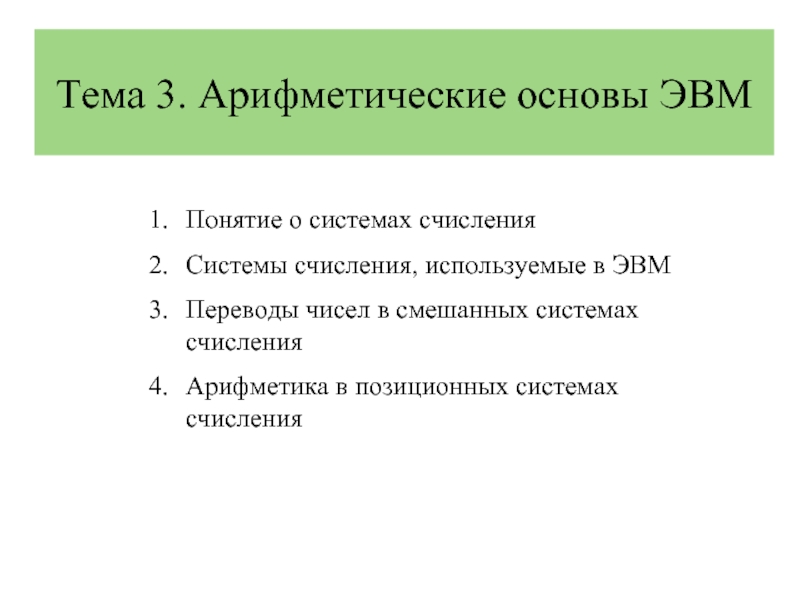- Главная
- Разное
- Дизайн
- Бизнес и предпринимательство
- Аналитика
- Образование
- Развлечения
- Красота и здоровье
- Финансы
- Государство
- Путешествия
- Спорт
- Недвижимость
- Армия
- Графика
- Культурология
- Еда и кулинария
- Лингвистика
- Английский язык
- Астрономия
- Алгебра
- Биология
- География
- Детские презентации
- Информатика
- История
- Литература
- Маркетинг
- Математика
- Медицина
- Менеджмент
- Музыка
- МХК
- Немецкий язык
- ОБЖ
- Обществознание
- Окружающий мир
- Педагогика
- Русский язык
- Технология
- Физика
- Философия
- Химия
- Шаблоны, картинки для презентаций
- Экология
- Экономика
- Юриспруденция
Fixed Points презентация
Содержание
- 1. Fixed Points
- 2. © O. Nierstrasz PS — Fixed Points 7.
- 3. © O. Nierstrasz PS — Fixed Points 7.
- 4. © O. Nierstrasz PS — Fixed Points 7.
- 5. © O. Nierstrasz PS — Fixed Points 7. Recall these encodings …
- 6. © O. Nierstrasz PS — Fixed Points 7.
- 7. © O. Nierstrasz PS — Fixed Points 7.
- 8. © O. Nierstrasz PS — Fixed Points 7.
- 9. © O. Nierstrasz PS — Fixed Points 7.
- 10. © O. Nierstrasz PS — Fixed Points 7.
- 11. © O. Nierstrasz PS — Fixed Points 7.
- 12. © O. Nierstrasz PS — Fixed Points 7.
- 13. © O. Nierstrasz PS — Fixed Points 7.
- 14. © O. Nierstrasz PS — Fixed Points 7.
- 15. © O. Nierstrasz PS — Fixed Points 7.
- 16. © O. Nierstrasz PS — Fixed Points 7. Unfolding Recursive Lambda Expressions
- 17. © O. Nierstrasz PS — Fixed Points 7.
- 18. © O. Nierstrasz PS — Fixed Points 7.
- 19. © O. Nierstrasz PS — Fixed Points 7.
- 20. © O. Nierstrasz PS — Fixed Points 7.
- 21. © O. Nierstrasz PS — Fixed Points 7.
- 22. © O. Nierstrasz PS — Fixed Points 7.
- 23. © O. Nierstrasz PS — Fixed Points 7.
- 24. © O. Nierstrasz PS — Fixed Points 7.
- 25. © O. Nierstrasz PS — Fixed Points 7.
- 26. © O. Nierstrasz PS — Fixed Points 7.
- 27. A quick look at the π calculus
- 28. © O. Nierstrasz PS — Fixed Points 7.
- 29. © O. Nierstrasz PS — Fixed Points 7.
- 30. © Oscar Nierstrasz ST — Introduction 1.
Слайд 2© O. Nierstrasz
PS — Fixed Points
7.
Roadmap
Representing Numbers
Recursion and the Fixed-Point Combinator
The typed
The polymorphic lambda calculus
Other calculi
Слайд 3© O. Nierstrasz
PS — Fixed Points
7.
References
Paul Hudak, “Conception, Evolution, and Application of
Слайд 4© O. Nierstrasz
PS — Fixed Points
7.
Roadmap
Representing Numbers
Recursion and the Fixed-Point Combinator
The typed
The polymorphic lambda calculus
Other calculi
Слайд 6© O. Nierstrasz
PS — Fixed Points
7.
Representing Numbers
There is a “standard encoding” of
Слайд 7© O. Nierstrasz
PS — Fixed Points
7.
Working with numbers
What happens when we apply
We can define simple functions to work with our numbers.
Слайд 8© O. Nierstrasz
PS — Fixed Points
7.
Roadmap
Representing Numbers
Recursion and the Fixed-Point Combinator
The typed
The polymorphic lambda calculus
Other calculi
Слайд 9© O. Nierstrasz
PS — Fixed Points
7.
Recursion
Suppose we want to define arithmetic operations
In Haskell we can program:
so we might try to “define”:
plus ≡ λ n m . iszero n m ( plus ( pred n ) ( succ m ) )
Unfortunately this is not a definition, since we are trying to use plus before it is defined. I.e, plus is free in the “definition”!
plus n m
| n == 0 = m
| otherwise = plus (n-1) (m+1)
Слайд 10© O. Nierstrasz
PS — Fixed Points
7.
Recursive functions as fixed points
We can obtain
rplus ≡ λ plus n m . iszero n
m
( plus ( pred n ) ( succ m ) )
rplus takes as its argument the actual plus function to use and returns as its result a definition of that function in terms of itself. In other words, if fplus is the function we want, then:
rplus fplus ↔ fplus
I.e., we are searching for a fixed point of rplus ...
Слайд 11© O. Nierstrasz
PS — Fixed Points
7.
Fixed Points
A fixed point of a function
Examples:
fact 1 = 1
fact 2 = 2
fib 0 = 0
fib 1 = 1
Fixed points are not always “well-behaved”:
succ n = n + 1
What is a fixed point of succ?
Слайд 12© O. Nierstrasz
PS — Fixed Points
7.
Fixed Point Theorem
Theorem:
Every lambda expression e has
∀e: Y e ↔ e (Y e)
Proof:
Let: Y ≡ λ f . (λ x . f (x x)) (λ x . f (x x))
Now consider:
p ≡ Y e → (λ x. e (x x)) (λ x . e (x x))
→ e ((λ x . e (x x)) (λ x . e (x x)))
= e p
So, the “magical Y combinator” can always be used to find a fixed point of an arbitrary lambda expression.
Слайд 13© O. Nierstrasz
PS — Fixed Points
7.
How does Y work?
Recall the non-terminating expression
Ω
Ω loops endlessly without doing any productive work.
Note that (x x) represents the body of the “loop”.
We simply define Y to take an extra parameter f, and put it into the loop, passing it the body as an argument:
Y ≡ λ f . (λ x . f (x x)) (λ x . f (x x))
So Y just inserts some productive work into the body of Ω
Слайд 14© O. Nierstrasz
PS — Fixed Points
7.
Using the Y Combinator
What are succ and
Слайд 15© O. Nierstrasz
PS — Fixed Points
7.
Recursive Functions are Fixed Points
We seek a
rplus ≡ λ plus n m . iszero n m ( plus ( pred n ) ( succ m ) )
By the Fixed Point Theorem, we simply take:
plus ↔ Y rplus
Since this guarantees that:
rplus plus ↔ plus
as desired!
Слайд 17© O. Nierstrasz
PS — Fixed Points
7.
Roadmap
Representing Numbers
Recursion and the Fixed-Point Combinator
The typed
The polymorphic lambda calculus
Other calculi
Слайд 18© O. Nierstrasz
PS — Fixed Points
7.
The Typed Lambda Calculus
There are many variants
The typed lambda calculus just decorates terms with type annotations:
Syntax:
e ::= xτ | e1τ2→ τ1 e2τ2 | (λ xτ2.eτ1)τ2→ τ1
Operational Semantics:
Example:
True ≡ (λ xA . (λ yB . xA)B→A) A →(B→A)
Слайд 19© O. Nierstrasz
PS — Fixed Points
7.
Roadmap
Representing Numbers
Recursion and the Fixed-Point Combinator
The typed
The polymorphic lambda calculus
Other calculi
Слайд 20© O. Nierstrasz
PS — Fixed Points
7.
The Polymorphic Lambda Calculus
Polymorphic functions like “map”
Need type variables to capture polymorphism:
β reduction (ii):
(λ xν . e1τ1) e2τ2 ⇒ [τ2/ν] [e2τ2/xν] e1τ1
Example:
Слайд 21© O. Nierstrasz
PS — Fixed Points
7.
Hindley-Milner Polymorphism
Hindley-Milner polymorphism (i.e., that adopted by
If:
then
is ok, but if
then
is a type error since the argument len cannot be assigned a unique type!
doubleLen len len' xs ys = (len xs) + (len' ys)
doubleLen length length “aaa” [1,2,3]
doubleLen' len xs ys = (len xs) + (len ys)
doubleLen' length “aaa” [1,2,3]
Слайд 22© O. Nierstrasz
PS — Fixed Points
7.
Polymorphism and self application
Even the polymorphic lambda
Recall that both Ω and the Y combinator make use of “self application”:
Ω = (λ x . x x ) (λ x . x x )
What type annotation would you assign to (λ x . x x)?
Слайд 23© O. Nierstrasz
PS — Fixed Points
7.
Built-in recursion with letrec AKA def AKA
Most programming languages provide direct support for recursively-defined functions (avoiding the need for Y)
(def f.E) e → E [(def f.E) / f] e
(def plus. λ n m . iszero n m ( plus ( pred n ) ( succ m ))) 2 3
→ (λ n m . iszero n m ((def plus. …) ( pred n ) ( succ m ))) 2 3
→ (iszero 2 3 ((def plus. …) ( pred 2 ) ( succ 3 )))
→ ((def plus. …) ( pred 2 ) ( succ 3 ))
→ …
Слайд 24© O. Nierstrasz
PS — Fixed Points
7.
Roadmap
Representing Numbers
Recursion and the Fixed-Point Combinator
The typed
The polymorphic lambda calculus
Other calculi
Слайд 25© O. Nierstrasz
PS — Fixed Points
7.
Featherweight Java
Igarashi, Pierce and Wadler,
“Featherweight Java: a
doi.acm.org/10.1145/320384.320395
Used to prove that generics could be added to Java without breaking the type system.
Слайд 26© O. Nierstrasz
PS — Fixed Points
7.
Other Calculi
Many calculi have been developed to
Object calculi: model inheritance and subtyping ..
lambda calculi with records
Process calculi: model concurrency and communication
CSP, CCS, pi calculus, CHAM, blue calculus
Distributed calculi: model location and failure
ambients, join calculus
Слайд 27A quick look at the π calculus
© Oscar Nierstrasz
Safety Patterns
ν(x)(x.0 |
→ ν(x)(0 | z → ν(x)(0 | x(y).0 | x → ν(x)(0 | 0 | 0) en.wikipedia.org/wiki/Pi_calculus new channel output input concurrency
Слайд 28© O. Nierstrasz
PS — Fixed Points
7.
What you should know!
Why isn’t it possible
What is a fixed point? Why is it important?
How does the typed lambda calculus keep track of the types of terms?
How does a polymorphic function differ from an ordinary one?
Слайд 29© O. Nierstrasz
PS — Fixed Points
7.
Can you answer these questions?
How would you
Is it possible to model real numbers? Why, or why not?
Are there more fixed-point operators other than Y?
How can you be sure that unfolding a recursive expression will terminate?
Would a process calculus be Church-Rosser?
Слайд 30© Oscar Nierstrasz
ST — Introduction
1.
Attribution-ShareAlike 3.0 Unported
You are free:
to Share —
to Remix — to adapt the work
Under the following conditions:
Attribution. You must attribute the work in the manner specified by the author or licensor (but not in any way that suggests that they endorse you or your use of the work).
Share Alike. If you alter, transform, or build upon this work, you may distribute the resulting work only under the same, similar or a compatible license.
For any reuse or distribution, you must make clear to others the license terms of this work. The best way to do this is with a link to this web page.
Any of the above conditions can be waived if you get permission from the copyright holder.
Nothing in this license impairs or restricts the author's moral rights.
License
http://creativecommons.org/licenses/by-sa/3.0/

